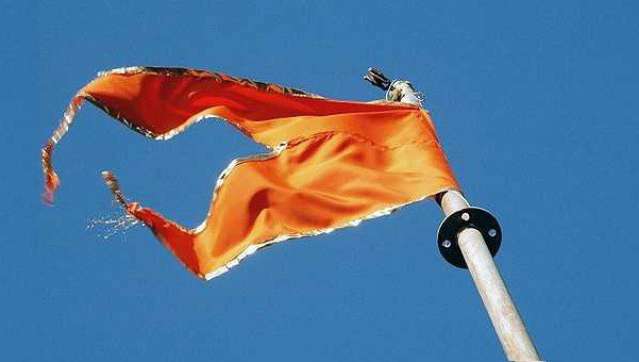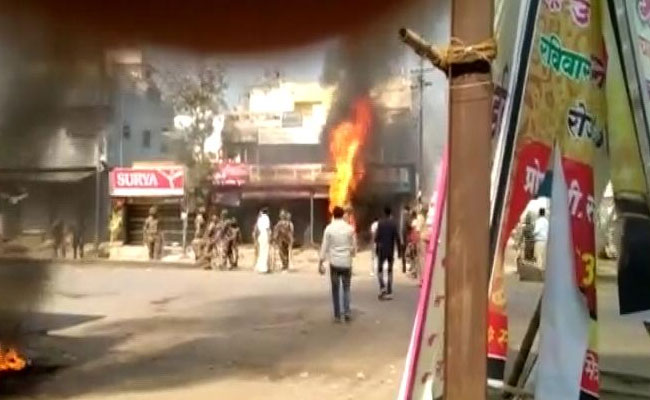
Monday’s attack has underlined, once again, how the current political climate emboldens perpetrators of violence against anyone not upper-caste Hindu. “It started with a series of ghastly lynchings of Muslims in the name of beef vigilantism. http://www.firstpost.com/india/una-alwar-and-delhi-cow-vigilantism-a-list-of-gau-rakshak-attacks-since-2015-dadri-lynching-3401302.html,” points out senior sociocultural historian Mukul Joshi who adds, “Militant vegetarianism, a manifestation of extreme otherising hate which saw offenders not only go scot free but actually being celebrated for their murder, violence and mayhem, has now given them a new-found brazenness.”
Though an imposition of Section 144 of the CrPC which prevents assembly of more than may have seen the return of an uneasy calm in the region this incident has sent shockwaves across Dalits in the country points out the late Dalit ideologue Ramakant Bansode. “This planned attack, executed with precision is driven by idea of squashing Dalit assertion. Brahminical upper castes conveniently forget how what they call ‘an anti-national celebration of British army’s victory’ is for us a mark of our fight for dignity as human beings.”
An obelisk installed at Koregaon soon after the 1818 battle to comemorate those who died fighting lists 49 East India Company soldiers, of these 22 names end with -nac (or -nak), then used exclusively by the Mahar community. This structure featured prominently on the Mahar Regiment’s crest until Indian Independence. “True it was built by the British but the obelisk is symbol to anyone who is in power or chooses to be, that they neglect the sizeable Dalit masses at their own peril,” beams Bansode.

This is the pride that gathers hundreds of Dalits, especially from the Mahar community on January 1st at Koregaon-Bhima village in Shirur tehsil of Maharashtra’s Pune district every New Year. It commemorates the Battle of Koregaon where the braveheart Mahars helped the vastly outnumbered British East India Company forces defeat the Maratha army of Peshwa Bajirao II.
Even as community leaders addressed the gathering on January 1st, a few phones kept going off to ringtones (Diwani and even Pinga) from Sanjay Leela Bhansali’s Bajirao Mastani, much to their chagrin. “Historians and filmmakers have denied us our historical legacy as Dalits. Why use ringtones and popular cultural symbols which glorify Brahmin supremacism?” reprimanded one such leader, Siddharth Waghmare who had come all the way from Parbhani with 12 followers.
Later the pharmacy graduate and die-hard Priyanka Chopra fan (“Uske saamne Deepika toh bachchi hai”), privately admitted to having watched the film several times. “Twice in the theatre and several times on my phone. Though I hate the over-glamourised celebration of Brahminical supremacy, one has to give it to Bhansali for leaving you gripped,” says the self confessed movie buff. “Past the heavy sets, costumes and music, scenes that stayed with me are the disparaging derogation which the Bajirao Peshwa’s mother Radhabai, brother Chimmaji Appa and even wife Kashibai have for Mastani just because she was born to a Muslim mother. While the film shows her being referred to as Yavani, the more popular invective in those days was actually mlenchcha (impure barbarian). Thankfully unlike the Marathi black and white historicals of the late 40s and early 50s this word is not used to describe Muslims in Bajirao Mastani.”
Echoing this, historian Dr Vijay More, a PhD on the Koregaon-Bhima battle, explains, “Exaggerated notions of purity in the name of religion were created by Brahmins to not only stay high up in the pecking order but also exploit those below. What Narendra Modi’s and Donald Trump’s governments are now doing by spreading hatred and creating fertile ground for alienation and further recruitment to terror, upper caste Hindus have done for a millennia with hateful casteist exclusion. This is what drove people away from Hinduism in the first place.”
Placing it in historical perspective, he points out how Shivaji Maharaj recognised the valour of braveheart Mahars and ensured they fought shoulder to shoulder with him. “Successive Chatrapatis too continued this tradition till 1674 when the Brahmin Peshwas (Prime Ministers) began to grow in power, sidelining even the royal family itself.”
Casteist supremacism
According to him Brahminical notions of puritanical exclusion began to then grow and became a part of social norm. “Peshwa Bajirao I (1719-1740) could spread the Maratha kingdom across the subcontinent because of the contribution of the brave Mahars, but disaffection due to discrimination grew rapidly after his death when barbaric cruelties against Dalits were perpetrated.”
He insists this was the real reason some of the bravest sardars of the kingdom moved away from Pune, up North to create their own kingdoms (Gaikwads in Baroda, Shindes in Gwalior, Holkars in Indore and Bhosales in Nagpur),” underlines Dr More. “As discrimination turned to casteist persecution, the Mahar braves began to get alienated. The British knew this and exploited it breaking the back of the might Maratha empire which then collapsed under its own weight.”
Waghmare sums it up beautifully pointing in the direction of the battle memorial, “This Koregaon obelisk, not only commemorates the brave and victorious Mahar soldiers but is also a symbol of the community standing up and winning against casteism. Little wonder then that our messiah for dignity-based-equality Dr Babasaheb Ambedkar himself visited this place on January 1st, 1927, creating a tradition we follow. For us this is not merely an obelisk. It is a dagger in the heart of casteist Hindus which we take pride in twisting every New Year.”
Like Dr More, he too believes that exclusion creates hard-to-forget hate. “Whether Students Islamic Movement of India in the early 2000, ISIS now or some of the more right-wing Muslim political outfits, the youth from these 1st or 2nd generation converts from Dalits form eager foot soldiers. This vicious cycle will only break when rationalist Hindus lobby long and hard enough to break the shackles of Manuwadi exclusion. Then they won’t need any ghar wapasi because who’ll want to leave?”
Hurtful exclusion
Over a 1,000 km away, another man is so angry and bitter with Hindu casteism that he’s just switched religions. 2015 didn’t end on a good note for Umrao Salodia, who now calls himself Umrao Khan after converting to Islam. Two New Years ago this chairman of Rajasthan Roadways Development Corporation quit alleging casteist discrimination on being passed over for promotion to chief secretary of the state.
The 1978 batch IAS officer says, “I felt being from the Scheduled Caste (SC) and a senior IAS officer, I’d be given a chance to work as chief secretary by the Vasundhara Raje government. I feel sad that the discrimination and victimisation I faced all these years as a Dalit, continued even at this level. I didn’t want to continue in a religion which robs me of my dignity with its casteist inequalities and hence converted to Islam.”
According to the senior bureaucrat much of the polarisation and hatred for Hindus comes from centuries of discrimination, “For hundreds of years, Indian society is structured around the rigid Hindu caste system. Though officially abolished in 1950, its legacy still continues. This hatred then comes back to haunt and hurt.”
Khan (Salodia) may have a point. Hindus constitute around 84% of India’s 1.2 billion. This large chunk, are still influenced by the concept of four main traditional castes, further divided into sub-castes and sects. Priests and academics who form the Brahmins; warriors, the Kshatriyas; traders or business community, the vaishyas and the working class the shudras/Dalits.
“Shudras have traditionally been made to to collect garbage, sweep streets, cremate dead and dispose human waste. Despite how essential their work is, they still fac prejudice and discrimination from upper-caste Hindus who don’t miss a single opportunity to humiliate them,” avers the bitter bureaucrat.
And yet there are those like rudra veena exponent Ustad Baha’ud’din Mohiuddin Dagar who feel that dwelling on the past bitterness is negative and does not yield anything. This 20th generation representative of the Dagar lineage (which traces its history back to Nayak Haridas Dagar of the 16th century) should know what Brahminical exclusion is all about.
“Our ancestor Baba Gopal Das was invited to the Mughal court to perform where impressed with his musical prowess the emperor offered a paan from his personal box,” recounts the musician. “Once he accepted the paan, his fellow Ramnami Pandits back in his village on the outskirts of Delhi said he’d been defiled and no penance could purify him to be acccepted. Left with no choice, this 8th generation representative of our gharana converted to Islam, and became Baba Imam Baksh in the mid-18th century.”
The family has since followed the festivals and tenets of both religions and goes to both temples and mosques alike. “Thinking of using religion to divide is petty. From childhood one has respected both religions. I think this approach can help one become both a better human being and hence a better musician.”
This musician’s strain finds resonance with Prakash Kapadia who wrote the screenplay for Bhansali’s Bajirao Mastani. “We never set out to preach or give any sermon through the film. That is neither Bhansali Sir’s nor my style. If the message of humanity, acceptance and love is coming wrapped with the beautiful love story we told, that’s fabulous. It is a mark of how involved audiences are becoming with what is unfolding on the screen.”
He points out a line in the film where Deepika Padukone’s Mastani laments how symbolism has hijacked religion. “I had written: ‘One religion has taken saffron for its colour, the other green. But is it possible for us to separate these out of the rainbow?’”
And just like it plays out in real life, unfortunately the last bit had to be cut at the editing table on reel too. And so much is the pity…
Will the dagger continue to twist?
